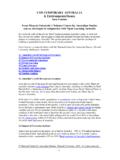Transcription of BARLEY - Food and Agriculture Organization
1 BARLEYPost-harvest Operations - Post-harvest CompendiumBARLEY: Post-Harvest Operations Organisation:The Central Research Institute for Field Crops, 226, Ulus, Ankara,Turkey Author: Taner Akar, Muzaffer Avci and Fazil Dusunceli Edited by AGST/FAO: Danilo Mej a, PhD, FAO (Technical) Last reviewed: 15/06/2004 Contents 2 1. Introduction .. 3 Socio economic impact of the crop .. 3 World Trade .. 5 Primary Product .. 7 Secondary and Derived Products .. 7 Quality Assurance .. 9 2. Post-Production Operations .. 10 Pre-harvest Operations .. 10 Harvesting .. 12 Transport .. 14 Threshing .. 14 Drying .. 15 Cleaning .. 16 Storage .. 16 Adobe depots.
2 17 Cement or pile depots: .. 17 Wooden depots: .. 17 Vertical wooden depots: .. 17 The vertical earth well depots: .. 19 Modern Silos: .. 20 Gender participation and post harvest operations .. 24 3. Overall Losses .. 24 4. Pests Control .. 25 Post harvest microorganisms .. 25 Post harvest pests .. 34 Control of post harvest microorganisms and pests .. 41 5. Economic and social considerations .. 46 6. References .. 48 7. Annex .. 58 Annex 1. Recipes of BARLEY foods containing BARLEY products .. 58 Annex 2: List of figures .. 64 BARLEY : Post Harvest Operations Page 2 Preface BARLEY is grown in about 70 million hectares in the world. Global production is 160 million tons.
3 Developing countries accounts for about 18 % (26 million tons) of total BARLEY production and 25 % ( million hectares) of the total harvested area in the world. BARLEY grain is mostly used as feed for animals, malt, and food for human consumption. Malt is the second largest use of BARLEY . Farmers also use BARLEY straw as animal feed in West Asia, North Africa, Ethiopia, Eritrea, Yemen, the Andes region and East Asia. BARLEY dominates other grains in some developing countries having arid and semi arid climates where it is the only cereal and only staple food resource. It is the fourth most important cereal crop in the world after wheat, maize, and rice. BARLEY is cultivated in Tibet, Nepal, Ethiopia, and the Andes on mountain slopes, only possible rain fed crop in North Africa, the Middle East, Afghanistan, Pakistan, Eritrea, and the Yemen.
4 Even in more developed countries, it is also very important species not only for animal feed but also for malting and exportation. Crop quality and post harvest operations are very important for human nutrition in dry areas, on the other hand economic development and farmer revenue for more humid areas. In the developing countries, farmers are mostly too poor to afford any loss of production. In general, BARLEY is more productive and its yield is more stable against seasonal variation than wheat and most of other small grains. Therefore, resource poor farmers tend to prefer BARLEY production. Successive poor production seasons leads farmers particularly those of poor to replace wheat with BARLEY for the aforementioned reasons.
5 In dry years, BARLEY flour is mainly used for bread making or it is added to wheat flour to make bread (Olu , 1946). The BARLEY crop is considered as a kind of guarantee against very low yield or crop failure risks. Due to the fact that BARLEY crop is utilized for animal feed as well as human nutrition, poor production and any kind of loss after harvest adversely affect farmers' livestock production and consequently socio-economic conditions. Growing crops and protecting them until consumption have been the major preoccupation of mankind since the inception of Agriculture . Storage is an essential interim operation in the food pipeline that moves crops from producer to processor and foodstuffs from processor to consumer.
6 It equilibrates the quantitative fluctuations derived from the imbalance of supply and demand. Hunger today may be threatening the lives of about 800 million people in the developing world, with approximately 60% of them living in Asia. People may suffer from food shortage or malnutrition heavily, especially in the poorest countries where agricultural production is never in surplus, where facilities for storage are lacking, and in regions subject to extreme climatic fluctuations from one year to the next (Navvaro, 1997). While post harvest production systems and post harvest losses are largely controlled by market imposed political and economical conditions in developed countries, ecological factors play more decisive role in those systems and losses in the developing world.
7 In developed countries qualitative aspects of food loss are of greater importance than the quantitative ones. In these countries cereal grains are stored in large centralized storage facilities or on-farm in bulk. Under these conditions quantitative losses are generally at low levels and therefore further loss reductions are not cost effective. Losses of biological origin such as grain or insect respiration, or limited drying due to aeration of grain in storage are common. These losses on an annual basis are usually less than 1%. Developing countries are characterized by small scale farming where deficiencies in handling and storage methods, and very often warm and humid climatic conditions promote rapid deterioration of the stored foodstuffs.
8 In developing countries the major portion of grain and pulses (sometimes up to 80% of the national production) is kept on the farms for home consumption. Post harvest BARLEY : Post Harvest Operations Page 3 losses in food grains in developing countries have been estimated conservatively during the 1980s as 10-15% by the FAO's Special Action Program for the Prevention of Food Losses. However, actual losses may be higher in certain areas depending on storage types and conditions. For example, losses of corn due only to insects in farmers' stores in Nigeria, Swaziland and Kenya, were estimated to be in the order of 6-10% (Navarro, 1997). 1. Introduction BARLEY (Hordeum vulgare L.)
9 Is one of the most important cereal crops in the world. It is widely grown fourth cereal and among top ten crop plants in the world. BARLEY was mainly cultivated and used for human food supply in the last century but nowadays it is significantly grown as animal feed, malt products and human food respectively. In addition, BARLEY is very well known as a model crop for plant breeding methodology, genetics, cytogenetics, pathology, virology and biotechnology studies (Hockett and Nilan 1985; Hogberg, 1987). BARLEY is mainly produced in unfavorable climate and soil conditions of the world. Wide adaptation to these conditions mentioned above, versatile utility mainly for animal feed and food and superiority for malt and beer industry as a raw material are the main reasons that enable BARLEY to be commonly cultivated crop plant over centuries.
10 BARLEY is cultivated in highly diverse regions of the world from 330 m below sea level near the Dead Sea in the Middle East up to 4200 m on Atipano and the Andes in Bolivia. Fertile Crescent of the Middle East consisting of Turkey, Iran, Iraq and Lebanon has been reported as original area of cultivation and most likely origin of BARLEY , the most ancient crop of cereals (Harlan, 1979). According to the excavations, BARLEY was domesticated in the Nile River Valley of Egypt at least year ago (Wendorf et al., 1979). Socio economic impact of the crop BARLEY is very important cereal in terms of 132 million tons production, 55 million ha acreage and t/ha yield in the world (Table ).













